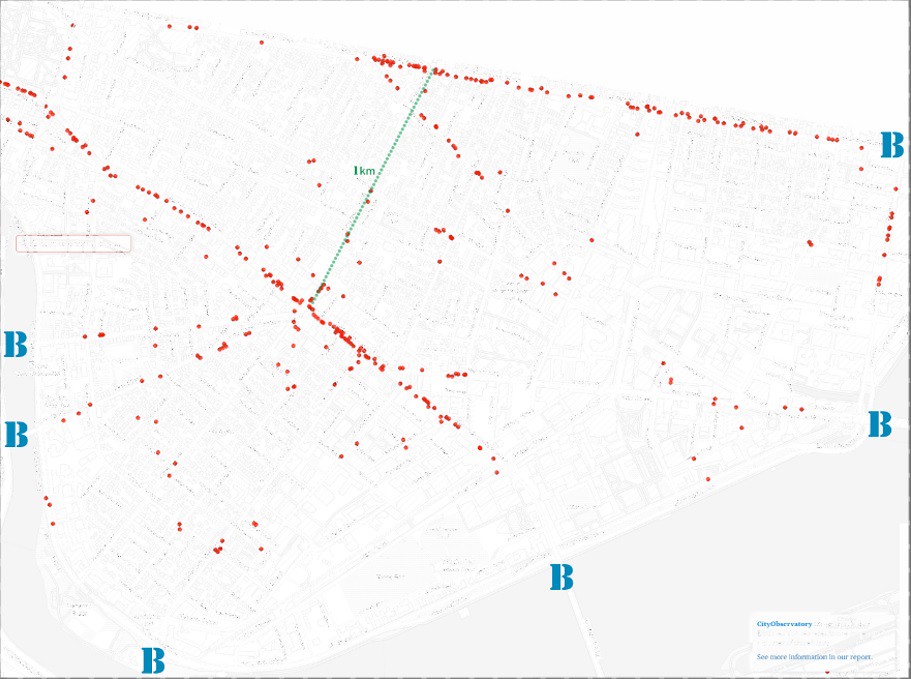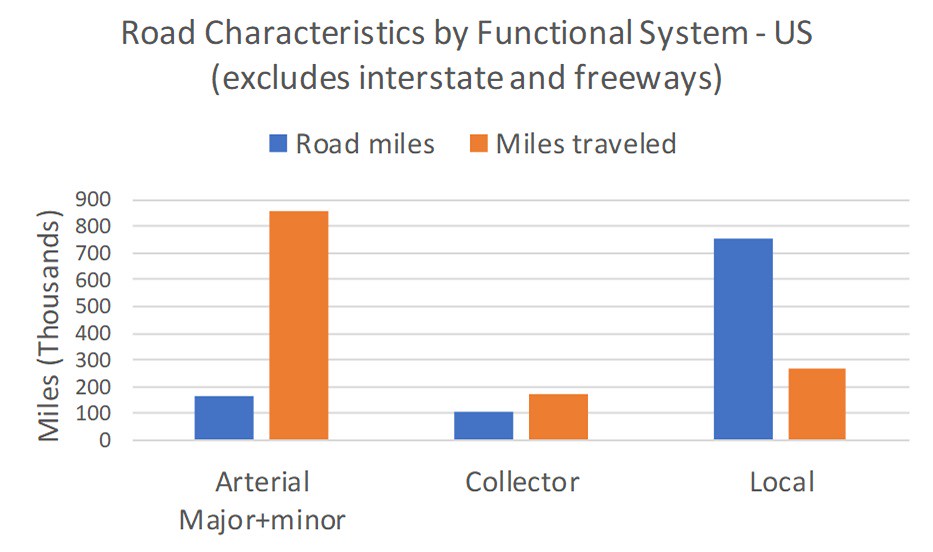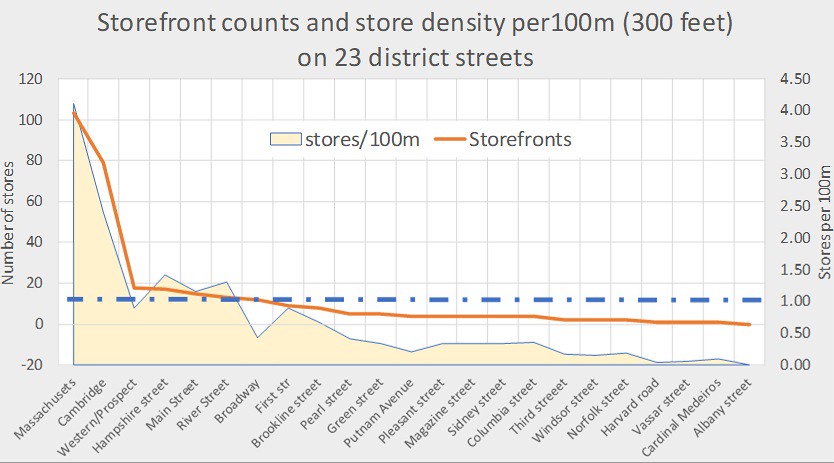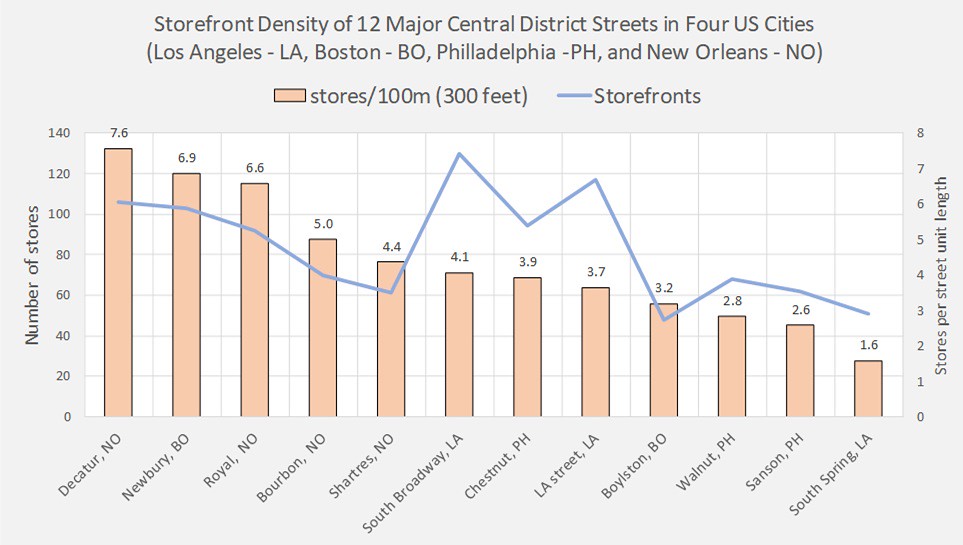
In her 1961 book, Jacobs made daring observations about how the “good city” works. A good number of passages in the book dealt with safety, such as the following:
“The basic requisite for such surveillance [of the street] is a substantial quantity of stores and other public places sprinkled along the sidewalks of a district; enterprises and public places that are used by evening and night must be among them especially. Stores, bars and restaurants, as the chief examples, work in several different and complex ways to abet sidewalk safety.”
In a previous article we quantified Jacobs’ “[…..] substantial number of these birds of passage,” referring to an unspecified ratio of transient tenants that a neighbourhood can absorb. “Substantial,” in the case of stores, is just as vague and unhelpful prescription for practice as the previous observation about transient tenants. Though the underlying principle stands, its application could falter for lack of specificity. The task of this article will be to quantify “substantial,” identify thresholds of significance, and search for the implications of numerical alternatives to vagueness.
Patterns of sprinkles
Figure 1, which encompasses six neighbourhoods in Cambridge, Massachusetts (about 6 km2 ), reveals identifiable patterns: First an obvious disproportionate concentration of storefronts (red dots) along two alignments that run through the district (East-West). Second, a much lower frequency along shorter longitudinal lines and far fewer dispersed dots in the N-S direction. Thirdly, absence of any dots on a high percentage of district streets.

Figure 1. A “sprinkle” of storefronts in Cambridge, Massachusetts (red= storefronts, B=bridges and a 1km (0.62 miles) green scale line. Source: Storefront Index database (drawing adapted by author).
This uneven pattern of storefront distribution, seemingly obscure, becomes fully transparent when understood in the context of the district’s circulation pattern. Five bridges (blue B,) linking Cambridge to Boston act as gates to it and beyond. Typically, the longer and more direct a link is to a bridge, the higher the concentration of stores on it. This symbiotic relationship between traffic and commerce is not only fully understood but also a cardinal rule for city and transportation planners. It is also intuitively taken for granted by store owners. Figure 2 demonstrates how commercial enterprises will appear mostly on roads that carry high enough traffic to support them; these routes, as a rule, are major and minor arterials. Indeed, Fig 1 visualizes indirectly a road’s characteristic: “arteriality”.

Figure 2. Local streets have over four times the length of the combined major and minor arterials but less than one third their traffic volume. Source: Road characteristics by functional system US 2007.
Though consistent with the traffic-commerce link, the area in Fig 1 is devoid of dots—an overwhelming majority—astounds by its sheer size. In a mature, compact, connected, and accessible district this dearth of shops is counterintuitive. Fig 3 lists 22 of its 127 streets (17% of total) that possess more than one storefront on their entire length. Setting aside the unfurnished 83%, we ask whether the frequency of stores in the active set qualify as a “substantial quantity.” No benchmarks exist to answer this question.

Figure 3. Cambridge neighborhood streets (22) on which storefronts appear at frequencies from 0.04 to 4.12 per 100 m (300 feet). Source: Storefront Index database (calculations by author).
About thresholds
Of the 22 district streets that have storefronts in Figure 3, 18 (80%) are either below or barely above a hypothetical threshold of one storefront per 100 m (300 feet) of street length. Such sporadic incidence hardly matches a common-sense expectation of “substantial number” and “variety” or those of typical sidewalk images of “walkable, vibrant, lively, mixed-use” streets. In spite of the absence of benchmarks, one storefront per block likely would be barely adequate for any noteworthy surveillance to materialize; neither by its own presence nor by the number of customers it could attract. Here we face a quantification impasse, or, alternatively, a challenge for more research.

Figure 4. Twelve streets in the central cores of four U.S. cities and their storefront frequencies.
To gain a perspective on store density, we looked at a set of 12 streets in the downtowns of four cities. There, the concentration of storefronts shown on maps appears the highest as compared to other, surrounding districts. Figure 4 shows storefront frequencies ranging from 1.6 per 300 feet to 7.6, an almost five-fold range, with an average of 4.3. These average and individual rates are much higher than those of Cambridge.
The large range, noticeable peculiarities of the rankings and inconsistencies between individual streets within districts raise intriguing questions. The range poses the question of whether it should be interpreted unquestionably as a linear progression of safety, as the introductory quote implies. If so, then a low threshold creates unacceptably unsafe conditions, at least in theory. A paradox also surfaces: in the same mature, compact and diverse districts, streets only a block or two apart show substantially different rates. For example, L.A.s’ South Spring Street has approximately one third (1.6) of South Broadway’s frequency (4.1). Nearby, Olive Street, Grand Avenue and Hope Street appear to have even lower frequencies. By L.A.’s own better streets figures, they are underperforming.
Another surprising contrast is between the frequencies of central streets in New Orleans that occupy three top tiers and those of L.A.’s (a city 10 times bigger) that hold two median and the lowest positions. Are we to surmise that LA’s downtown is less compact, diverse, and lively than New Orleans, or that it lacks sufficient surveillance? It's impossible to judge without an objective scale.
So far, we have wrestled a tentative average storefront frequency from available data but gained little certainty about its meaning or its practical use in neighbourhood planning.
Upgrades and the “invisible hand”
We can now estimate the number of storefronts that would be needed to upgrade Cambridge’s streets, should they be judged as “dull,” unsafe, or inadequately furnished. To bring all 18 under-furnished streets to at least one storefront per 100 m, 180 new stores would be required and, to raise the average of all 23 to 4 per 100 m, the number would be 1052. These additions would mean a 50% increase in stores in the first instance and over 300% in the second, a massive addition.
Assuming that these additions were deemed necessary to “improve” the district, based on a set of yet unknown premises, introducing them by fiat would run into an array of procedural obstacles and systemic flaws of top-down planning. More critically, it would defy Jacob’s own perspective, now prevalent among planners, that: "When we deal with cities we are dealing with life at its most complex and intense […].” Jacobs emphasized that point by asking “Why have cities not [,… ,] been identified, understood and treated as problems of organized complexity?”
In practical terms, this means that growth and change in city districts follow organic rules, the results of which are indeterminate and which become only clear following their manifestation. A pattern in the making has no identifiable shape. “The Invisible Hand” of organic growth is shaping and reshaping the built environment constantly.

Fig.5. Corner of Cambridge and Hampshire streets in Cambridge. Circles indicate the introduction of storefronts in existing residential buildings (source: Google Maps).
For example, Figure 5 shows seven manifestations of unpredictable land-use changes that produced storefronts on three streets. As evidence in all central, mature districts demonstrates, these types of mutations are the rule rather than the exception. The birth, life and death of individual stores unfold “in different and complex ways” and cannot be foreseen, managed, or dictated.
Conclusion
In this brief exploration, we identified at least one numerical equivalent to the vague “sprinkle of stores” recipe but could not establish benchmarks for sufficiency. A street’s equivalent of a Body Mass Index (i.e., a "Healthy Store Density and Variety Index") has yet to be invented.
One significant quantity, however, emerged from this analysis. It became evident that, on average, the vast majority of streets—about 70-80%—in any district similar to Cambridge (approx. 6 km2 ) will be devoid of stores; there is simply not enough traffic on every street to nourish them or sufficient local population to support them. This finding implies that most streets will forever be dull, with little variety, and hardly any activity on them, even when they are part of a compact and walkable district. Unremarkable as they may be, they could also be pleasant, safe, and even illustrious. Examples of such good streets abound; Allan Jacobs took notice of some.
In planning and rebuilding, it is unwarranted, and futile, to portray “vibrant, healthy and safe” streets by means of storefront density and diversity; most cannot ever achieve such features. Such an idealized, reassuring portrayal is most certainly a recipe for disillusionment. The life of streets cannot be drawn on paper or decreed as a policy prescription; it is fundamentally organic in nature.
This article was originally published in Planetizen.
Fanis Grammenos is the director Urban Pattern Associates in Ottawa, Ontario and the author of Remaking the City Grid: A Model for Urban and Suburban Development. Reach him by email with questions or comments.












